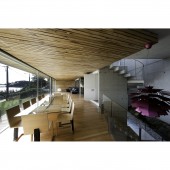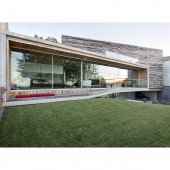
| THE AWARD |
| CATEGORIES |
| REGISTRATION |
| SUBMIT YOUR WORK |
| ENTRY INSTRUCTIONS |
| TERMS & CONDITIONS |
| PUBLICATIONS |
| DATES & FEES |
| METHODOLOGY |
| CONTACT |
| WINNERS |
| PRESS ROOM |
| GET INVOLVED |
| DESIGN PRIZE |
| DESIGN STORE |
| THE AWARD | JURY | CATEGORIES | REGISTRATION | PRESS | WINNERS | PUBLICATIONS | ENTRY INSTRUCTIONS |
Dezanove House by iñaki leite |
Home > Winners > Design #55171 >Interview |
 |
|
FS: What is the main principle, idea and inspiration behind your design?
IL: The Dezanove House takes its inspiration from its surroundings. The coastline and is scattered with mussel farms: neatly arranged platforms made of Eucalyptus wood, off which ropes are hung with the oysters and mussels for which the region is famed. The house, tucked into the rocky coastline with sea views, borrows from the traditions of its surroundings using this same Eucalyptus wood and it's tecnology. Integrating the local culture was very important in the design. I was keen to ensure a sense of harmony between building and setting.
FS: What has been your main focus in designing this work? Especially what did you want to achieve?
IL: Definitely the integration of the building in the surrounding was the most important achievement, not only chromatically but culturally, to achieve relaxing spaces for the house. The recycled nature of the wood, taken from former mussel farms, gives the building a rough and natural aesthetic, made contemporary by the glass and concrete. The same materials run throughout the inside of the home, but the wood used is a smoother, warmer cut. Wooden ceilings give the space a cosy atmosphere, and pay homage to its coastal surroundings.
FS: What are your future plans for this award winning design?
IL: I will try to develop new solutions for the integration on the designs using traditional materials, traditional technologies and also the traditional shapes too.
FS: How long did it take you to design this particular concept?
IL: Actually it was a bit long as the process did not come without its challenges. It was about 12 months long because the sloping plot, rocky setting and newly enacted planning restrictions all threatened to make the project very challenging. The design is always influenced by the site. But, the planning regulations were very restrictive in the area, because it’s on the waterfront. At the same time, the site is pretty short, so I had to optimize the design to the constraints: in positioning and volume. However we were able to overcome these difficulties, and even use them to our advantage, resulting in a house that is sheltered by the rock and open to the sea.
FS: Why did you design this particular concept? Was this design commissioned or did you decide to pursuit an inspiration?
IL: I grew up in this particular coastal area of the country, so several ideas about the shape, use, materials and location were just coming up very naturally.
FS: Is your design being produced or used by another company, or do you plan to sell or lease the production rights or do you intent to produce your work yourself?
IL: n/a
FS: What made you design this particular type of work?
IL: It is always my approach to look the surroundings the first thing to understand all the dynamics and flows in all levels, including economy and culture.
FS: Where there any other designs and/or designers that helped the influence the design of your work?
IL: n/a
FS: Who is the target customer for his design?
IL: n/a
FS: What sets this design apart from other similar or resembling concepts?
IL: The way of the use of the reclaimed wood and the shape of the old booths of the "bateas" turned into a house. There is no precedent in the area at all.
FS: How did you come up with the name for this design? What does it mean?
IL: Actually the name is exactly the postal number of the house on the street but in galician language.
FS: Which design tools did you use when you were working on this project?
IL: I've used to work with plenty of sketches by hand, as well as physical models. Additionally I've used 3D modelling for the client to understand in very detail the whole design in advance prior to the site building.
FS: What is the most unique aspect of your design?
IL: I believe it is not only the use of the reclaimed wood but the richness of the space because of the material, especially in the interior of the house. Also integrating the local culture was very important.
FS: Who did you collaborate with for this design? Did you work with people with technical / specialized skills?
IL: I've designed only on my own even the key furniture of the house: kitchen, kitchenette, dining, and more… And it was all designed accordingly to the design of the house and its materials.
FS: What is the role of technology in this particular design?
IL: Energy efficiency and sustainability were also key to the design. In addition to using recycled materials, the home is highly efficient through ground source heat pump for underfloor heating and cooling, as well as mechanical ventilation with recovery system and three heat exchangers (evaporative patio, canadian shaft and fireplace exchanger).
FS: Is your design influenced by data or analytical research in any way? What kind of research did you conduct for making this design?
IL: The old booths on the "bateas" are from the 70's or early 80's, so I've used my own memories as child for the definition of the shape. The very detail was the result of several visits and research about the local fishing industry of the "bateas", where I've collected the reclaimed wood too.
FS: How did you decide to submit your design to an international design competition?
IL: My friends really and the reaction of some people about the design of the house push me to submit it for this award.
FS: Thank you for providing us with this opportunity to interview you.
A' Design Award and Competitions grants rights to press members and bloggers to use parts of this interview. This interview is provided as it is; DesignPRWire and A' Design Award and Competitions cannot be held responsible for the answers given by participating designers.
| SOCIAL |
| + Add to Likes / Favorites | Send to My Email | Comment | View Press-Release | Translations |





